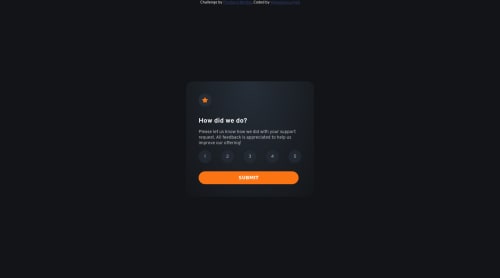Interactive rating component

Solution retrospective
There is a bug when you hover after selecting and deselecting the rating. I am unsure about the way I wrote the css file. I believe there is a lot to improve. Any feedback is welcome.
Please log in to post a comment
Log in with GitHubCommunity feedback
- @AdrianoEscarabote
Hi Mohamed Lajnef, how are you? I really liked the result of your project, but I have some tips that I think you will enjoy:
Document should have one main landmark, this problem is being caused by the fact that there is no main tag around the main content of the page! Since this challenge is based on only one component, there is no other component more important than it on this page, so to solve this, wrap all the content with the
maintag,It's always good to pay attention to the correct use of semantic html elements, as they are extremely important for people who use screen readers, to know what the main content of the page is in the case of the
maintag!To improve the accessibility of the project you could have put an h1. Every page must contain a level 1 header, for people who use screen readers, identity what the main title is and follow the sequence h1-h5
<h1>How did we do?</h1>The rest is great!
I hope it helps... 👍
Marked as helpful - Account deleted
Hey there! 👋 Here are some suggestions to help improve your code:
-
Do not forget to update your code with everything the report found to be incorrect.
-
The “icons/illustrations” in this component serve no other purpose than to be decorative; Their
alt tagshould be left blank and have anaria-hidden=“true”to hide them from assistive technology.
More Info:📚
https://www.w3.org/WAI/tutorials/images/
- The "rating buttons" should not be built using the
anchorelement, since theanchoris for linking internal/external content.
- The proper way to build the "rating buttons" in this challenge is to create a
formand inside of it, there should be fiveinput radiosand eachinputshould have alabelattached to it to make the buttons accessible. Finally wrap all theinputsandlabelsinside afieldsetto prevent users from making more than one selection.
More Info:📚
MDN <fieldset>: The Field Set element
If you have any questions or need further clarification, feel free to reach out to me.
Happy Coding!🎄🎁
-
Join our Discord community
Join thousands of Frontend Mentor community members taking the challenges, sharing resources, helping each other, and chatting about all things front-end!
Join our Discord